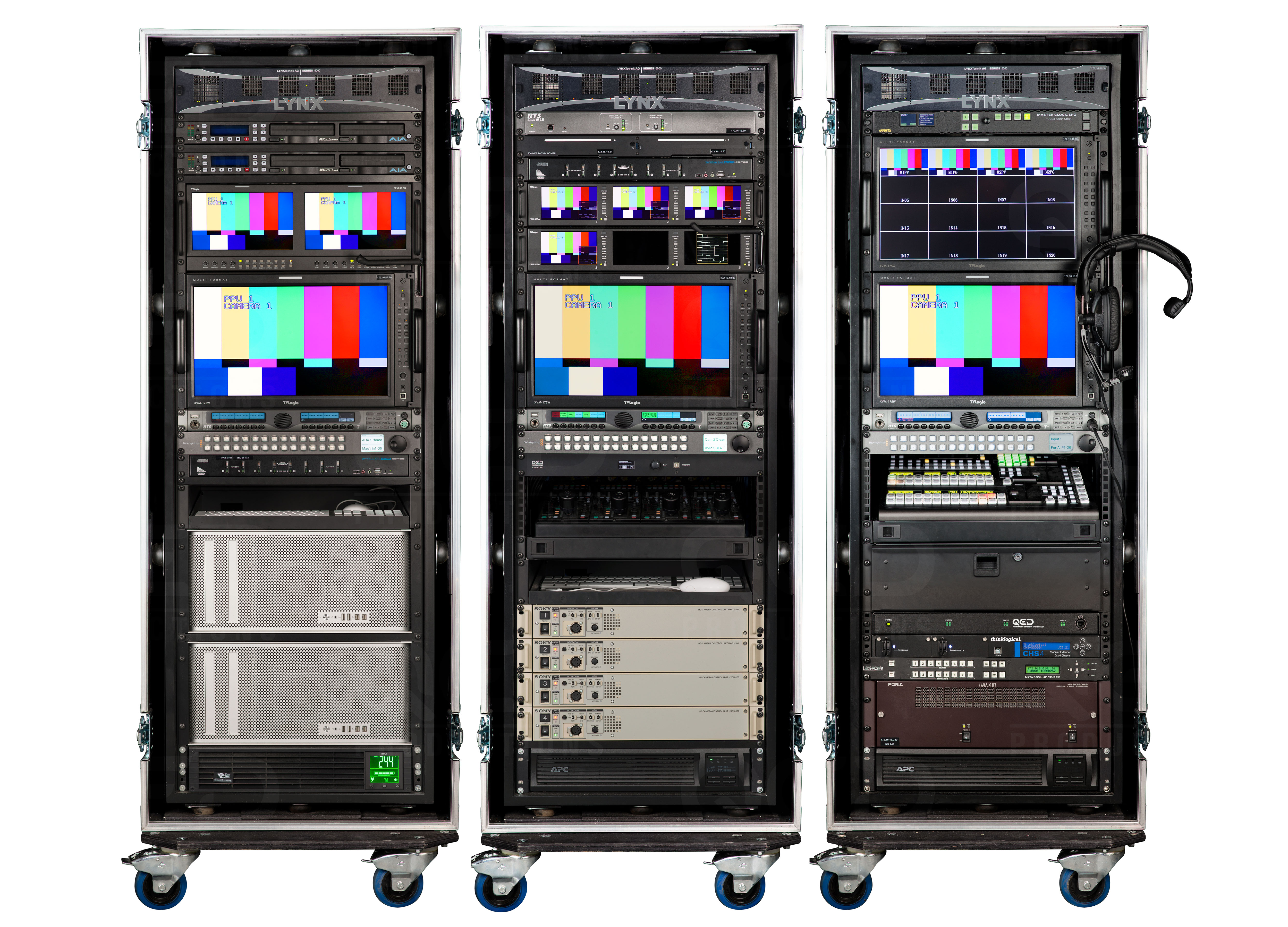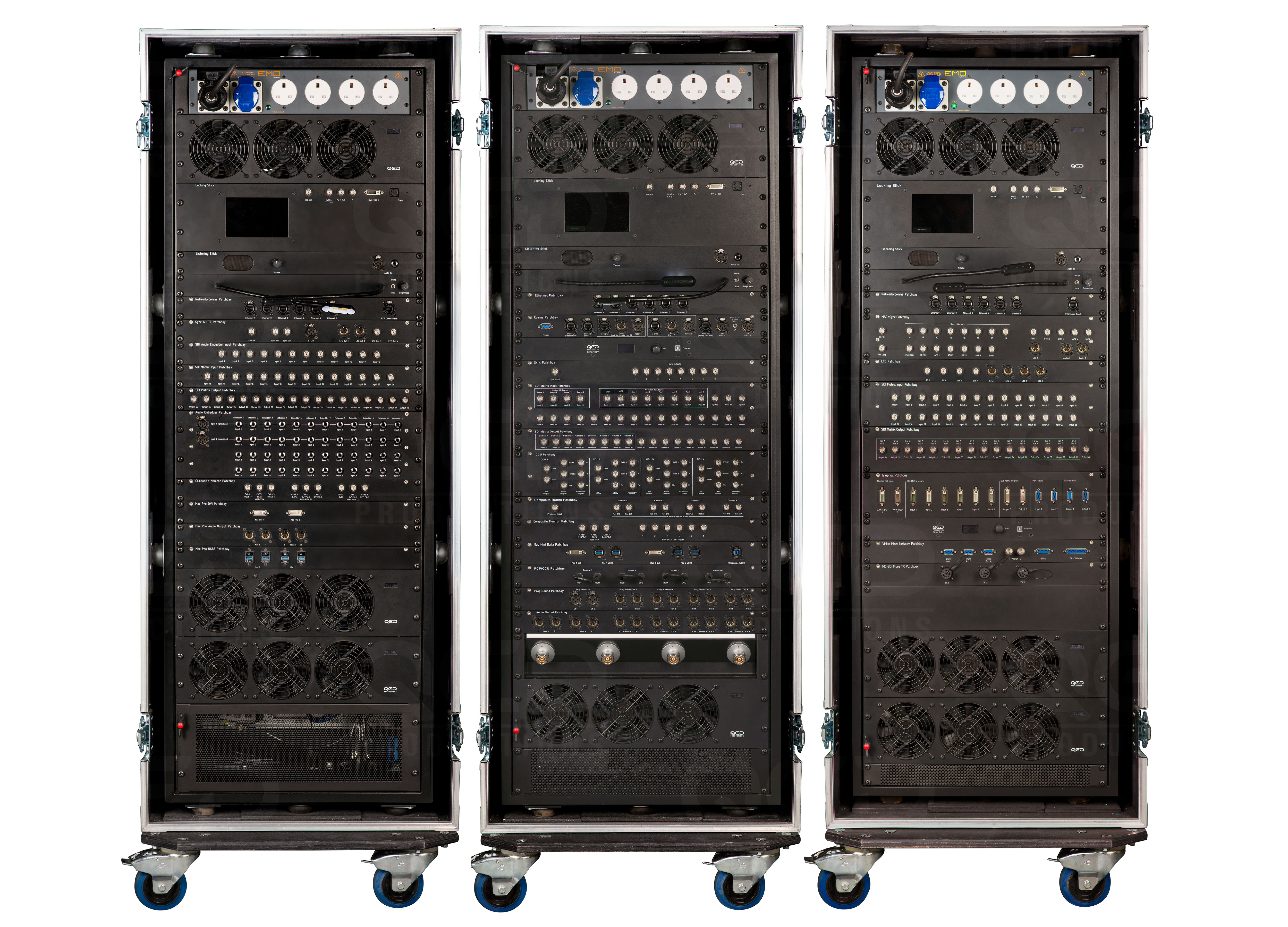The HD PPU has already been used on a number of high-profile events gaining entirely positive feedback from engineers, directors and clients alike.
The system is divided into three 32U wheeled, shock-mounted racks. The size of the racks was carefully chosen to provide sufficient space for all equipment, placing critical control panels and monitors in ergonomic positions, whilst still being able to fit through a standard single doorway, even with the reduced headroom that self-closers, alarm sensors and the like provide. The system has already been used in locations as diverse as Wembley Stadium, The Echo Arena Liverpool, Grosvenor House, Trafalgar Square and in a small office at a client's London headquarters.
Each rack is fitted with a UPS to provide continuity of power to all critical components in the event of a power failure as well as internal and external lighting. There are common design features between racks to aid the on-site engineer. For example, the full-height patch panels on the rear of each rack is hinged to allow easy access to the interior of the rack should it be necessary. There is also a Lynx Technik Series 5000 frame in the top of each rack to deal with distribution of sync, audio, time-code and other signals as appropriate.
To further assist the engineer the rear-mounted 'Looking stick' on each rack provides a small HD monitor to permit visual confirmation of signal presence on a patch connector without having to leave the rear of the rack. Likewise, a 'Listening Stick' is provided - a panel with XLR and balanced jack inputs featuring a small amplifier and loudspeaker permitting local testing of audio patch points.
QED sends the HD PPU system out on the road with a default 'serving suggestion' setup to enable the on-site engineer to instantly get things up and running, but with the fully integrated system control the engineer is free to set up the system quickly and easily to exactly the specification they require.
Production Rack
The Production Rack is the heart of the system and is based around the For-A HVS-350HS vision mixer. Much time was spent researching and testing different vision mixers and it was clear that for this application, the multi-format For-A product was the perfect choice.
Inputs
Besides the usual HD-SDI inputs, the HVS-350HS has four input option slots, permitting direct connection of computer graphics and analogue sources without any external conversion. This eliminates the delay inherent in external processing and allows, for example, a number of DVI graphics sources to be connected directly to the mixer and appear instantly as conventional sources on the vision mixer's control panel. Likewise, analogue sources (e.g. component SD from a DVD player) may be connected directly to the system - again without external processing. All scaling is done within the vision mixer permitting almost any source type and resolution to be connected directly. With the system usually working at 1080i/50 there is no need to deal with graphics sources with an external graphics switcher as all sources can be dealt with by one operator in a single place.
Although all HD-SDI sources within the PPU are fully genlocked and synchronous, a frame synchroniser may be switched on within the mixer for any input where it is necessary to provide an asynchronous source.
Outputs
The HVS-350HS provides a Programme output, a Mix/Effects output and six Aux outputs on HD-SDI, any of which can be set to show any source or mix bus. This allows huge flexibility in signal routing within the mixer, and permits, for example, a simple way to provide two independently mixed screen feeds for an event from one single unit. Additionally there are two output option slots which may be configured for DVI, VGA, component or even composite video. Any of these option outputs may be configured to show any input or output from the mixer. For instance, if an event requires LCD or Plasma relays around the venue, these may be fed directly from the mixer's DVI output allowing conventional monitors to be used rather than ones featuring HD-SDI input options or by using multiple HD-SDI converters.
DVI Routing
The Production Rack has an in-built Lightware 8x8 DVI matrix switcher. This allows DVI sources to be routed to mixer inputs and mixer outputs routed to individual or multiple output connectors as convenient. The rack also contains a QED three-way DVI fibre transmitter incorporating Ethernet. Therefore for long runs DVI may be converted to fibre to feed projectors, monitors, etc. entirely within the rack. This has been designed to work with QED's popular FibreShoe™ receivers allowing DVI signals and Ethernet control via a single fibre-optic cable.
Monitoring
Two TVLogic 17" Grade 1 monitors are provided at eye-line height for the operator. In normal use these are fed from the two multi-view generators built into the vision mixer via Aux outputs 5 & 6. These may be laid out in any of a number of configurations, and of course any source or output may be assigned to any tile within either multi-viewer.
HD-SDI routing
All HD-SDI signals are routed via a BlackMagic 40x40 matrix permitting quick and simple signal routing as preferred. The BlackMagic Master Control panel provides a simple way to set up the routing and provides useful names for sources and destinations to facilitate quick and easy routing on site.
System Sync
The sync for the system is generated by an Evertz 5600MSC master sync pulse generator. Besides the Tri-level sync distributed within the racks this also generates timecode to synchronise recorders, and may also generate Black & Burst SD sync entirely synchronous with system sync to allow genlock of external devices which require Black & Burst rather than tri-level sync.
Engineering Rack
If the Production Rack is the heart of the system, then the Engineering Rack is the brains of the system. The Engineering Rack provides full control for the four onboard camera channels and monitoring for other sources and system controls.
Camera Channels
The rack is designed around the popular Sony HXC-100 camera system. Four HXCU-100 CCUs are permanently mounted in the rack and all facilities are provided. Industry standard Lemo 4M connectors are provided on the rear of the rack for triax connection to the camera heads.
For the camera operators, independent Production and Engineering communications circuits are provided, and a custom QED tally system allows fully configurable red and green tallies to be routed to the cameras as required. All camera channels are provided with two Production Audio channels, the levels of which can be set by each individual camera operator as preferred.
All audio output links are provided in the patchbays, allowing the cameras' XLR audio channels to be linked to the sound department if required. This can be a huge time saver if audio is required from a remote camera location, by providing a pair of audio paths down each camera triax rather than laying in additional audio cables.
Four channels of return video are available to each camera - two HD-SDI and two composite video. The two HD-SDI returns for each camera are assignable via the rack's matrix, allowing each operator to have their own preferred return feeds. Access to the composite video returns are via the rear patchbay should they be required. A system-wide 'prompter' composite video input is also provided should a teleprompting feed be required at or near any camera position.
Camera Control
Four Sony RCP-1500 Remote Control Panels are provided on an angled, pull-out drawer. These provide all standard controls over the camera channels. A custom QED touchdown interface allows switching of the main engineering monitor from the joystick touchdown or preview buttons on the RCPs as would be expected plus an option for momentary or latched monitor switching operation to the engineer's preference.
Monitoring
A TVLogic Grade 1 17" engineering monitor is provided. This may be switched using the RCP touchdown controller, or via the adjacent matrix control panel as preferred. Standard waveform monitors and a Vectorscope are in-built for signal analysis, however for more critical applications a BlackMagic Ultrascope is also built into the rack to provide full broadcast 'scopes and monitoring on an external computer connected via USB3. A further six 5" monitors are provided via a pair of TVLogic PRM-503s, primarily for source monitoring of the cameras, but any source can be assigned to any monitor via the matrix.
Communications
An RTS Zeus IIILE digital communications matrix features in the Engineering rack. This fully programmable matrix provides comms support for the cameras, keypanels in all HD PPU racks as well as external keypanels and devices, including support for two channels of two-wire comms. The Zeus III allows maximum flexibility and straightforward integration into other comms systems - for example, links to a two-wire 'show' ring to allow communications between PPU operators and a show caller. The panel to the rear has been designed for ease of connection to comms panels; connections to other RTS keypanels is via standard Cat5 cable and breakouts have been provided on the panel to permit easy connection of IEM wireless systems for presenter earpieces. One port has been specifically wired to interface with HME wireless talkback systems in order to provide seamless integration of wireless comms into the PPU system. Two channels of Programme Audio are also injected into the comms system, allowing each operator to set their own level of programme audio as desired.
Control
Two rack-mounted Apple Mac minis are provided. These are set up to boot to either Mac OSX or Windows. The Windows environment provides all control software across the HD PPU racks, permitting set-up of the BlackMagic matrices, RTS comms, Lynx Technik frames, etc. Outputs from these Mac minis are switched via a KVM to the engineering monitor and a mouse and keyboard are provided in a pull-out tray below the RCPs.
All devices supporting Ethernet control are cabled via Ethernet hubs in their respective racks and a single Cat5 link between each rack is all that is required to achieve full control from a single point. Of course control from an external laptop is also possible if preferred.
'Second Head' outputs from the Mac minis are provided via DVI connectors on the patchbay, which would permit their use as graphics sources into the vision mixer if required, and the usual graphics software (Keynote, PowerPoint, etc) is provided to support this. Stereo balanced audio outputs from the Mac minis are also provided.
Audio
As the Engineering Rack contains the RTS comms matrix it also contains DAs for programme audio. Internally programme audio is distributed to the camera channels and into the comms system, and four pairs of outputs are provided to distribute the programme audio feeds further - for example, into the Ingest Rack.
Cameras
QED supplies Sony HXC-100 camera heads to run with the HD PPU. Every camera head is supplied flight-cased with its accessories and an EFP kit. A high quality monochrome HDVF-20A viewfinder is included for handheld use and for studio style operation a top quality Sony HDVF-EL75 7" colour OLED viewfinder is provided. The cameras are supplied fitted with a Canon HJ22ex7.6B IASE lens, complete with ZSD-300D and FPD-400D zoom and focus demands. For longer shots, Canon HJ40 lenses can also be supplied. For outdoor work, full-size 'studio' rain covers or smaller 'handheld' rain covers can be supplied. QED supplies Vinten Vision 250 tripod systems or Vinten Pro-Ped OB pedestals. A Beyer DT108 or DT109 camera operators' headset is also supplied with each camera -Peltor ear-defending headsets can be optionally supplied for work in noisy environments.
Carefully selected ultra-flexible 8.5mm black triax cable is supplied for the cameras. The cable was chosen so as to be visually unobtrusive when used in corporate environments whilst still being sufficiently rugged to withstand the rigours of more heavy-duty use. A careful balance has been chosen between the look of the cable and transmission distance - the 8.5mm triax has been successfully tested with the HXC-100s at distances of up to 550m and is supplied on a wheeled stackable drum system in 100m lengths together with a shorter 30m cable.
QED have chosen to use the industry standard Lemo 4M ('BBC Spec') triax connectors to permit easy integration into clients' existing systems and to take advantage of existing building infrastructures where available.
Recording Rack
The Recording Rack has been designed to seamlessly integrate into the PPU to provide straightforward recording of all channels of video.
MacPros and Just:In
The rack is provided with two Apple MacPros each supporting five channels of HD-SDI recording via ToolsOnAir Just:In software. This allows up to ten streams of HD-SDI video to be recorded simultaneously in both standard Apple QuickTime MOV and MXF container formats.
USB3 connections are provided for rapid transfer of recorded files to external hard drives for client use and the Mac Pros are also networked via Gigabit Ethernet for rapid file transfer.
AJA KiPros
In addition to the Mac-based Just:In system, two AJA KiPro Racks are provided to enable independent recording of a further two streams of HD-SDI, making the rack capable of recording up to twelve simultaneous streams of HD-SDI.
Signal Routing
HD-SDI inputs to the rack are routed via twelve 4-channel audio embedders and onwards to a BlackMagic HD-SDI matrix. This permits any source to be routed to any or to multiple recording channels, making it impossible to accidentally split a video stream from its respective audio channels.
We have not only placed a large emphasis on the speed and ease of setup but also on flexibility. The audio patching requires that only a single (or pair) of XLR programme audio feeds are provided. By default these audio feeds duplicate to audio channels 1&2 on all recorders, however use of normalisation on the audio patchbay allows insertion of any chosen audio feed directly onto any channel of any stream if desired.
Audio channels 3&4 for each recorder are available on the patchbay and may be fed individually as required. Therefore, it is possible to record up to 48 individual channels of audio in addition to the twelve streams of HD-SDI.
All recorders are synchronised to system tri-level sync and all are provided with system timecode, ensuring that all recorded files' timecodes are synchronised for use in post production.
Monitoring
A TVLogic 17" grade 1 monitor is provided in the rack. This is fed from the two MacPros via a KVM switch to permit monitoring of either Mac. An Apple keyboard and mouse are provided in a pull-out tray, also connected via the KVM. A TVLogic PRM902-Q monitor pair provide, by default, monitoring of the two AJA KiPros although the sources for these monitors can be easily adjusted via the matrix.
Control
A BlackMagic Smart Control is provided for easy setup of the matrix routing above which is an RTS keypanel linked to PPU comms.
Playback
The MacPros may optionally be used as VT playback machines. DT VideoLabs Playback Pro software is provided for such use. 'Second head' DVI outputs from each Mac are available on the patchbays, as are stereo balanced audio outputs.
Operation Philosophy
The entire HD PPU system has been designed to provide the highest quality whilst remaining straightforward and logical to set up. There are only a small number of links to be made between the racks to provide an operational system:
- Ethernet links to permit system-wide control. QED's custom designed system also routes tally signals via Ethernet.
- Sync (genlock) connections
- Comms panel connections
- Timecode connections
In terms of signal links, of course it is entirely up to the engineer how they wish to set up the system, and all matrices and patchbays have been designed to offer maximum flexibility in signal routing. However, the HD PPU has been designed around the concept that all HD-SDI signals arrive at the Engineering Rack first, link on to the Production Rack and then onwards to the Recording Rack. In addition return links are made from the Production Rack back to the Engineering rack. All connections to facilitate this are highlighted and duplicated on the respective patchbays as necessary. By using this methodology every HD-SDI source is available to the Engineer and to the vision mixer, and every output is available to the Engineer. Use of 'friendly' names for all connections on the patchbays means that an engineer unfamiliar with the system can immediately begin patching rather than needing to refer to a schematic to decipher cryptic codes. All spare matrix inputs and outputs are available on the patchbays to maximise flexibility.
Of course, there are times when all engineers need to do something out of the ordinary, and each Engineering Rack Mac mini has a folder on its desktop containing full schematics of the system, and user and service manuals for the equipment.





